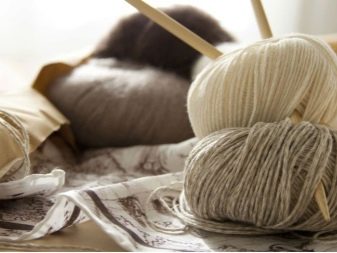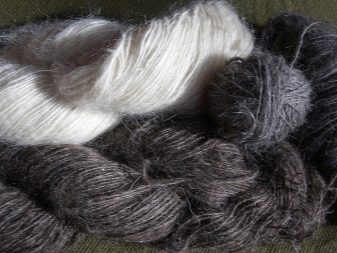Mongolian cashmere: characteristics and features of choice

With the onset of cold weather, clothes made of soft and warm cashmere become relevant. Mongolian cashmere is a wonderful material with unique properties, which is created only in the harsh climate of the Mongolian mountains.
Specifications
Many people think that cashmere is this type of wool, but in reality it is not. Cashmere is much thinner and warmer (eight times) than wool, because it is produced not from the hair (wool) cover of goats and sheep, but from the fluff of these animals, or, as it is called in another way, the undercoat. Cashmere yarn is created only from the undercoat of goats that live in the highlands of Mongolia. Actually, the name of cashmere comes from the foothill Himalayan region - Kashmir. Breeding these goat breeds in other climates does not produce such a high quality undercoat.


The properties of the unique Mongolian yarn, first of all, are its lightness and softness: a three-hundred-gram cloth can be easily passed through a woman's ring. Such properties are explained by the finest downy fiber: each hair of the undercoat is three to four times thinner than a human hair. And due to the fact that the fluff is also hollow inside, cashmere products have high thermal insulation and can be worn both in cold and hot weather.
Thanks to their undercoat, Tibetan goats can easily withstand strong temperature changes during the day: from forty-degree daytime heat to twenty-degree frost at night.

Despite its weightlessness and thinness, high-quality cashmere is a very durable material and durable. Pumps on the canvas are formed after a long time of use, partly in places of friction, but they also straighten after a properly carried out wash. This material has other qualities as well.
- It is safe for allergy sufferers.The down of Tibetan goats is absolutely hypoallergenic, microscopic mites do not grow in it. Cashmere knitwear is suitable for making clothes and bedspreads even for newborns.
- It is gentle to the skin, does not prick it and does not cause itching.
- It is able to treat diseases of the joints and spine with its dry, penetrating warmth. In addition, a cashmere item worn on a naked body has a massage effect on the skin.


Features of production
The negative property of cashmere is its high cost in comparison with the same wool. This is due to a complex production process and a small yield of undercoat from one Tibetan goat per year: only about 160 g. All stages of cashmere production are carried out manually, technologies have not been modernized for several centuries. Plucking the down from goats is also rarely done: once a year, in the spring, when there is no danger that the animal will freeze.
For a shawl of standard sizes, you will need an undercoat taken from 6-7 goats.


The undercoat is sorted by color and quality. Natural fibers can be white (the most valuable), gray, beige and black. First, the finest fiber is selected, from which a delicate yarn called pashmina is made. Coarser fibers become the basis for creating "soft gold" from Mongolia - cashmere. Quality cashmere linen is always handcrafted from processing and spinning to dyeing. Clothes from it fit perfectly on the figure, they are warm and comfortable.


How to choose and take care of?
The main and obvious criterion for choosing a quality cashmere is its price. The approximate price by which one can judge its quality is at least 3 thousand rubles per 1 m2. Even in the homeland of production, in Mongolia, this cost will not significantly decrease. TAlso, when choosing cashmere products, experts advise relying on some criteria.
- When you pick up the cashmere material, you should not feel its weight.
- After running your hand over the canvas, the villi should remain in place, and not scatter in different directions. Fragile particles indicate the low quality of the cashmere fiber.
- The product tag should contain information about the double weaving of the thread. Since cashmere yarns are very thin, double-twisted yarns will last longer.

- Lack of pellets. Pilling is not typical for cashmere items. They appear only after improper use or very long wear.
- A cashmere canvas, claiming to be of high quality, should be so dense that when you look at it, glimpses will not be visible. The translucent sheet will not warm up properly.
- After stretching it with your hands, the cashmere product should regain its original shape. If traces of stretch marks remain, the item is of poor quality.
- Pay attention to the quality of the seams, to their accuracy and lack of curvature, because a thing made of expensive delicate linen should serve for more than one season.


Proper care of cashmere products will help ensure long wear and maintain good appearance. First of all, this concerns washing: it must be very gentle.

It is necessary to adhere to the rules of washing things made of this precious material.
- It is recommended to remove stains on the cashmere linen as soon as possible under cold water using non-aggressive liquid baby soap.
- Cashmere items are not machine washed, even if the washing machine has delicate and gentle modes.
- It is better to dry-clean items with strong and old stains. However, all the risks should be taken into account, since the thing may lose the brightness of its color.
- Hand wash cashmere products only in cold water up to 30 ° C and with liquid detergent. Consider baby shampoo as a liquid.


- Places with dirt are not rubbed and in no case squeezed, but rinsed gently and smoothly.
- After washing, the item should be gently rinsed several times in cold water until the detergent is washed off.
- Without plunging the spin, it is better to blot the water from the washed item with a hygroscopic towel.

- The cashmere item for drying should be gently flattened on a horizontal surface away from heating appliances or sunlight.
Iron the cashmere at a low temperature (no more than 120 ° C) on the back side using damp gauze.
At the end of the season, the cashmere item should be stored. It is better not to hang it on a hanger, but carefully pack it without creases in a paper bag, putting a moth repellent in it.

Reviews
Nowadays, things made of one hundred percent cashmere, including because of the price, are a rare occurrence. But modern technologies make it possible to make various mixes of cashmere and other natural and synthetic materials. Pure yarn from a sub-set of Tibetan goats is added to costume, coat fabrics and fine knitwear, and then hats, shawls, ponchos, business suits for men and women, coats, parkas and cardigans are sewn.
After analyzing the reviews of people who purchased things both from pure cashmere and in composition with other materials, we can say that, on the whole, they are satisfied. With proper use, things are worn for a long time, do not deform, and such an unpleasant phenomenon as pellets can appear in the third or fourth year of wearing. Unfortunately, only its high cost remains a negative point.
For the production of Mongolian cashmere, see the next video.








